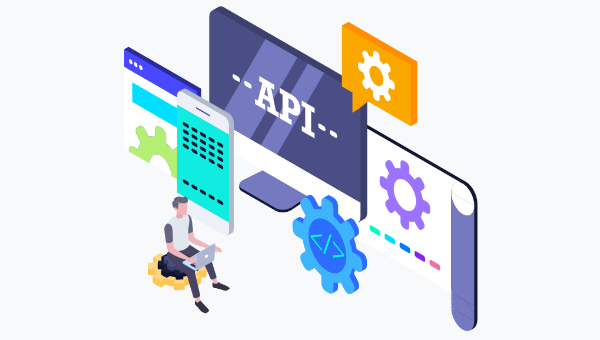Best Practices For Designing Your First RESTful API
This article presents you with an actionable list of 13 best practices. Let’s explore!1. Use HTTP methods correctly
We’ve already discussed the possible HTTP methods you can use to modify resources: GET, POST, PUT, PATCH, and DELETE. Still, many developers tend to abuse GET and POST, or PUT and PATCH. Often, we see developers use a POST request to retrieve data. Furthermore, we see developers use a PUT request which replaces the resource while they only wanted to update a single field for that resource. Make sure to use the correct HTTP method as this will add a lot of confusion for developers using your RESTful API. It’s better to stick to the intended guidelines.2. Naming conventions
Understanding the RESTful API naming conventions will help you a lot with designing your API in an organized manner. Design a RESTful API according to the resources you serve. For example, your API manages authors and books (yes, a classic example). Now, we want to add a new author or access an author with ID3. You could design the following routes to serve this purpose:
- api.com/addNewAuthor
- api.com/getAuthorByID/3
- POST api.com/authors
- GET api.com/authors/3
3 has ever written? Also for this case, RESTful APIs have a solution:
- GET api.com/authors/3/books
5 for an author with ID 3. Again, let’s follow the same structured approach to form the following endpoint:
- DELETE api.com/authors/3/books/5
3. Use plural resources
Resources should always use their plural form. Why? Imagine you want to retrieve all authors. Therefore, you would call the following endpoint:GET api.com/authors.
When you read the request, you can’t tell if the API response will contain only one or all authors. For that reason, API endpoints should use plural resources.
4. Correct use of status codes
Status codes aren’t here just for fun. They have a clear purpose. A status code notifies the client about the success of its request. The most common status code categories include:- 200 (OK): The request has been successfully handled and completed.
- 201 (Created): Indicates the successful creation of a resource.
- 400 (Bad Request): Represents a client-side error. That is, the request has been malformed or missing request parameters.
- 401 (Unauthorized): You tried accessing a resource for which you don’t have permission.
- 404 (Not Found): The requested resource doesn’t exist.
- 500 (Internal Server Error): Whenever the server raises an exception during the request execution.
5. Follow casing conventions
Most commonly, a RESTful API serves JSON data. Therefore, the camelCase casing convention should be practiced. However, different programming languages use different naming conventions.6. How to handle searching, pagination, filtering, and sorting
Actions such as searching, pagination, filtering, and sorting don’t represent separate endpoints. These actions can be accomplished through the use of query parameters that are provided with the API request. For example, let’s retrieve all authors sorted by name in ascending order. Your API request should look like this:api.com/authors?sort=name_asc.
Furthermore, I want to retrieve an author with the name ‘Michiel’. The request looks like this api.com/authors?search=Michiel.
Luckily, many API projects come with built-in searching, pagination, filtering, and sorting capabilities. This will save you a lot of time.
7. API versioning
I don’t see this very often, but it’s a best practice to version your API. It’s an effective way of communicating breaking changes to your users. Frequently, the version number of the API is incorporated in the API URL, like this:api.com/v1/authors/3/books.
8. Send metadata via HTTP headers
HTTP headers allow a client to send additional information with their request. For example, theAuthorization header is commonly used for sending authentication data to access the API.
A full list of all possible HTTP headers can be found here.
9. Rate Limiting
Rate limiting is an interesting approach to control the number of requests per client. These are the possible rate limiting headers your server can return:- X-Rate-Limit-Limit: Tells the number of requests a client can send within a specified time interval.
- X-Rate-Limit-Remaining: Tells how many requests the client can still send within the current time interval.
- X-Rate-Limit-Reset: Tells the client when the rate limit will reset.
10. Meaningful error handling
In case something goes wrong, it’s important that you provide a meaningful error message to the developer. For example, the Twilio API returns the following error format:{
"status": 400,
"message": "Resource books does not exist",
"code": 24801,
"more_info": "api.com/docs/errors/24801"
}
11. Choose the right API framework
Many frameworks exist for different programming languages. It’s important to pick a framework that supports the RESTful API best practices. For Node.js, back-end developers love to use Express.js, whereas for Python, Falcon is a great option.12. Document your API
Lastly, write documentation! I’m not joking; it’s still one of the easiest ways to transfer knowledge about your newly developed API. Although your API follows all best practices outlined for RESTful APIs, it’s still worth your time to document various elements such as the resources your API handles or what rate limits apply to your server. Think about your fellow developers. Documentation drastically reduces the time needed to learn about your API.13. Keep it simple!
Don’t overcomplicate your API and keep resources simple. A proper definition of the different resources your API handles will help you to avoid resource-related problems in the future. Define your resources, but also accurately define its properties and the relationships between resources. This way, there’s no room for dispute on how to connect the different resources. If you liked this article explaining API best practices, you might also enjoy learning about building a RESTful API from scratch.Frequently Asked Questions (FAQs) on Building RESTful APIs
What are the key principles of RESTful APIs?
RESTful APIs operate on a set of key principles that make them efficient and reliable. These principles include statelessness, where each request from a client to a server must contain all the information needed to understand and process the request. Another principle is cacheability, where responses must define themselves as cacheable or non-cacheable to prevent clients from reusing stale or inappropriate data. RESTful APIs also adhere to a client-server architecture, meaning the user interface and data storage are separated, improving scalability and portability.
How do I ensure my RESTful API is scalable?
Scalability is a crucial aspect of RESTful APIs. To ensure scalability, consider implementing rate limiting to control the number of requests a client can make within a certain timeframe. Also, use pagination to limit the amount of data returned in a single response. This not only improves performance but also enhances user experience. Lastly, consider using a load balancer to distribute network traffic across multiple servers, ensuring your API can handle high traffic loads.
What is the role of HTTP methods in RESTful APIs?
HTTP methods play a significant role in RESTful APIs as they define the type of action to be performed on the resource. The most common methods include GET (retrieve a resource), POST (create a new resource), PUT (update an existing resource), DELETE (remove a resource), and PATCH (partially update a resource). Each method corresponds to a specific operation in the CRUD (Create, Read, Update, Delete) model.
How can I secure my RESTful API?
Security is paramount in RESTful APIs. To secure your API, consider implementing authentication and authorization mechanisms such as OAuth or JWT. Also, use HTTPS to encrypt data in transit and prevent man-in-the-middle attacks. Regularly update and patch your API to fix any security vulnerabilities and consider using rate limiting to prevent brute force attacks.
What is the importance of versioning in RESTful APIs?
Versioning is important in RESTful APIs as it allows developers to make changes or updates to the API without breaking existing clients. There are several ways to implement versioning, including URI versioning, parameter versioning, and header versioning. Regardless of the method used, versioning ensures backward compatibility and smooth transition when changes are made.
How can I improve the performance of my RESTful API?
To improve the performance of your RESTful API, consider implementing caching to reduce server load and response time. Also, use compression techniques to reduce the size of the data being transferred. Optimize your database queries to reduce latency and consider using a Content Delivery Network (CDN) to deliver data faster to users located far from your server.
What is the role of status codes in RESTful APIs?
Status codes in RESTful APIs provide information about the result of a request. They are grouped into five classes: informational (1xx), successful (2xx), redirection (3xx), client errors (4xx), and server errors (5xx). Using appropriate status codes helps clients understand the response from the server and take appropriate action.
How do I handle errors in RESTful APIs?
Error handling is crucial in RESTful APIs. When an error occurs, return a meaningful error message along with the appropriate HTTP status code. The error message should be clear and concise, providing enough information for the client to understand what went wrong and how to fix it.
What is HATEOAS and how is it used in RESTful APIs?
HATEOAS (Hypermedia as the Engine of Application State) is a constraint of the REST architecture that allows for self-descriptive messages and the ability to navigate the API exclusively through hypermedia. This means that the API provides information about its own structure and how to interact with it, making it more user-friendly and easier to navigate.
How do I test my RESTful API?
Testing is a crucial part of developing RESTful APIs. You can use tools like Postman or Insomnia for manual testing. For automated testing, consider using frameworks like JUnit (for Java), pytest (for Python), or Mocha (for JavaScript). Ensure to test all aspects of your API, including functionality, performance, security, and error handling.
Fullstack Blockchain Developer at TheLedger.be with a passion for the crypto atmosphere.





